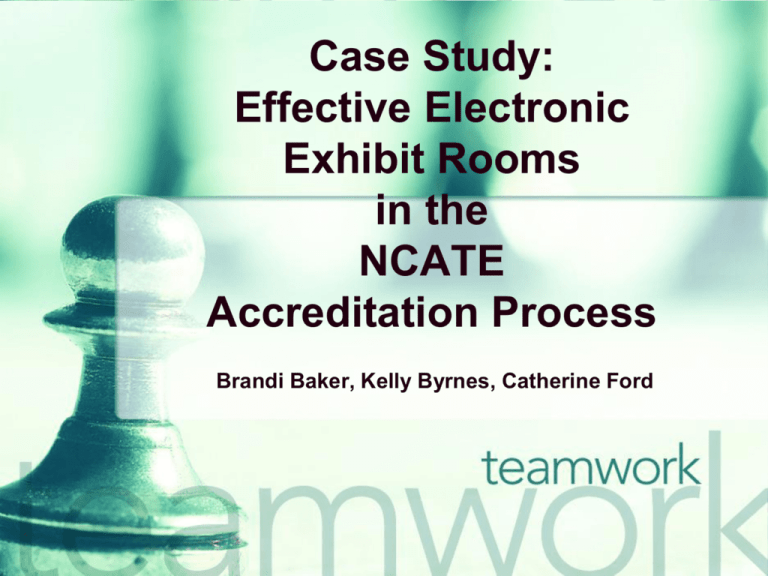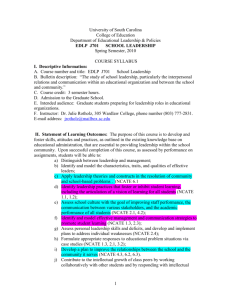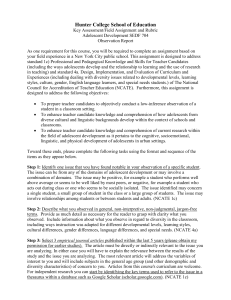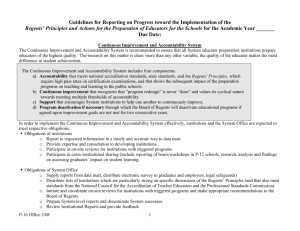Analysis - University of Toledo
advertisement

Case Study: Effective Electronic Exhibit Rooms in the NCATE Accreditation Process Brandi Baker, Kelly Byrnes, Catherine Ford Case Study Thinking . . . Preparation to determine current trends and areas of emphasis regarding EERs Retrieval of current information Reviewed web sites Recent articles in the topic of EERs Actual interviews for the IT piece Case Study Team’s intent regarding CONTENT determine exhibit requirements placed on units undergoing NCATE accreditation suggest best practices that will defend compliance with accreditation standards Team’s intent regarding IT PIECE AND SITE USABILITY make recommendations gleaned from current literature and personal interviews Final Products: Research Paper & EER Evaluation Checklist The EER needs to include all of the following: 1. Aligned to NCATE standards General Background and Conceptual Framework Standard 1: Candidate Knowledge, Skills and Professional Dispositions Standard 2: Assessment System and Unit Evaluation Standard 3: Field Experiences and Clinical Practices Standard 4: Diversity Standard 5: Faculty Qualifications, Performance and Development Standard 6: Unit Governance and Resources Each Standard has several Elements Each Element has a number of required exhibits – all must be available Quality of each Exhibit is paramount 2. Conceptual Framework This is what will drive the design of the EER 3. Simplicity and Consistency Use of Sans serif font No more than 5-7 colors Education department and NCATE logo at the top of each page No or few pictures No duplication of documents 4. Documentation PDFs Templates Whenever possible, create web pages to house information and data 5. Ease of Navigation Buttons along the top Left-hand navigation bar Information is in a hierarchical order Drop-down menus as needed Site Map User Manual Tracking capability Effective Electronic Exhibit Rooms in the NCATE Accreditation Process History & Challenges Presented by: Brandi Baker NCATE NCATE, created in 1954, celebrates it's 58th year in 2009. Started as an independent accrediting body by five organizations 1. Council of Chief State School Officers, 2. National Education Association, 3. National School Boards Association 4. American Association of Colleges for Teacher Education 5. National Association of State Directors of Teacher Education Certification. NCATE NCATE is part of a continuum of teacher preparation and development that begins with pre-service preparation, and continues with stages of teacher licensure and advanced professional development, including National Board certification. According to the NCATE website, 49 states along with the District of Columbia, Guam, and Puerto Rico, all have accredited institutions This is up from only 31 states with accredited units in 2004. Currently, Arizona is the only state without any NCATE accredited units. NCATE Early in NCATE's history the states and the accreditation body had challenges with state and national policy alignment with their standards. Reviews by NCATE and the states were done separately. Duplication of effort for institutions In 2004, NCATE and the states formed a partnership to allow joint review. Now many states use NCATE’s unit standards as their own for the purpose of state approval. NCATE Another challenge that has been overcome by NCATE is the performance-based accreditation system. From 1980 to 1990 NCATE went through what some titled a “standards movement” in which NCATE brought in performance-based accreditation. This is a system in which institutions must provide evidence of competent teacher candidate performance. This change supported a transition from a system oriented to the curriculum to a system oriented to candidate performance. NCATE In 2004 NCATE initiated a technology-based system of accreditation. NCATE now expects institutions to fully incorporate technology into instruction for prospective and experienced teachers Technology should also be used throughout the strategic planning process (NCATE at 50, 2001), electronic portfolios for example. Now, in 2009, streamlining of the accreditation process is evident through the use of web based forms and Electronic Exhibit Rooms, as well as assessment programs such as Electronic Assessment System (EAS) designed and used by the University of Toledo, Judith Herb College of Education. NCATE In conjunction with the technology based system of accreditation, Electronic Exhibit Rooms are now being utilized. Electronic Exhibit Rooms (EERs) are commonly prepared as an institution progresses toward an accreditation site visit from the National Council on Accreditation of Teacher Education (NCATE). EERs can also be utilized long after the site visit and accreditation award are complete, allowing continuous updating and sharing of significant materials that relate to accreditation, student assessment and professional development. Effective Electronic Exhibit Rooms in the NCATE Accreditation Process Why EERs & Exhibit Requirements Presented by: Catherine Ford Electronic Exhibit Rooms Why electronic??? Allows Board of Examiners to view documents prior to the site visit BOE are able to be more prepared BOE have more time to look for items of quality Electronic Exhibit Rooms Why electronic??? Institution can use the site for continuous updating Assessment Curriculum Vitae The site can be shared among stakeholders The site can act as a storage location Electronic Exhibit Rooms Organization Organization is VITAL The right document must be able to be easily found at the right time. Do not duplicate documents . . . Instead create links, as needed, to the same document. Electronic Exhibit Rooms Documents Organize exhibits by the standards Connect each exhibit to a specific element General Background and Conceptual Framework Standard 1: Candidate Knowledge, Skills, and Professional Dispositions Standard 2: Assessment System and Unit Evaluation Standard 3: Field Experiences and Clinical Practice Standard 4: Diversity Standard 5: Faculty Qualifications, Performance, and Development Standard 6: Unit Governance and Resources Effective Electronic Exhibit Rooms in the NCATE Accreditation Process IT Considerations Presented by: Kelly Byrnes Electronic Exhibit Rooms: Lessons Learned “The formation of a team of individuals to research, plan, produce, and implement, and should consist of a webmaster, clerk, multimedia author, and a technical systems expert.”--Zimmerly and Saltzman, Idaho State University Know when enough is enough! “No matter how beautiful a website, if it doesn’t have the proper documentation and is aligned to the NCATE standards, it will not help in the accreditation process; but a terrible design, even if it has everything, can sink you if the Board of Examiners can’t find what it wants!” C. Damon Osborne, PhD., Assoc. Prof. and Dir. Of Online Curriculum, Mt. Vernon Nazarene University. What Makes an Excellent EER? 1. 2. 3. Aligned to NCATE Standards Driven by the Conceptual Framework Simple and Consistent 4. Use of sans serif font No more than 5-7 colors Institution and or department logo No or few pictures Documentation/Links PDFs, Templates, separate web pages What Makes an Excellent EER? 5. Ease of Navigation A. Buttons along the top a. Left-hand navigation bar b. Information is in a hierarchical order c. Drop-down menus as needed B. Site Map C. User Manual Technical Aspects “As far as the technical aspect goes, we used IIS, TomCat, JSP Technology, XML, MS-Frontpage and Flash. The biggest technical challenge we faced was getting TomCat to interface with IIS. The site currently runs on a Dell Power Edge 2850 with Windows Server 2003 SP1. It's an Intel Xeon 2.80 GHz processor with 2GB or Ram. The server has 3 disks, a 36GB system drive that is mirrored, and two data drives. The D: drive is 146GB and it is 97% free. The E: drive is 146 GB and is 99% free. There isn't much storage space involved.” Todd Cunningham, Executive Director of Information Technology Services at the Indiana University of Pennsylvania References Becoming a Teacher at The University of Toledo. (2008, February 15). Retrieved February 22, 2009, from http://www.utoledo.edu/education/Becoming_Teacher.html Electronic Assessment System Tutorial. (2006). Retrieved February 22, 2009, from http://www.utoledo.edu/education/centers/carver/pdf/EAS_Student_Tutorial_with _Port.pdf Hammond, C.J. (2007). Electronic Exhibit Room ( . . . not so scary). Retrieved February, 4, 2009 from /Jackson %20Hammond%20rev%20PPT%20Elec%20Exh%20... Malone, S. (2007) Preparing the Electronic Exhibit Rooms. Retrieved February, 4, 2009 From coe.eku.edu/2008NCATE-Fall-Update/Presentations/Strand%20D_ Electronic %20Exhibit_Malone.ppt NCATE at 50: Continuous Growth, Renewal, and Reform. (2001). Retrieved February 22, 2009, from http://www.ncate.org/documents/15YearsofGrowth.pdf NCATE and the States: Partners in Excellence. Retrieved February 22, 2009, from http://www.ncate.org/documents/resources/NCATEandtheStates.pdf Zimmerly, C.R. and Salzman, S. (2002). Electronic Journal for the Integration of Technology in Education. In Technical Lessons Learned from the Design, Development, and Implementation of a College of Education Accreditation Web Site. Retrieved March 18, 2009, from http://ejite.isu.edu/Volume1No1/Zimmerly.html.





